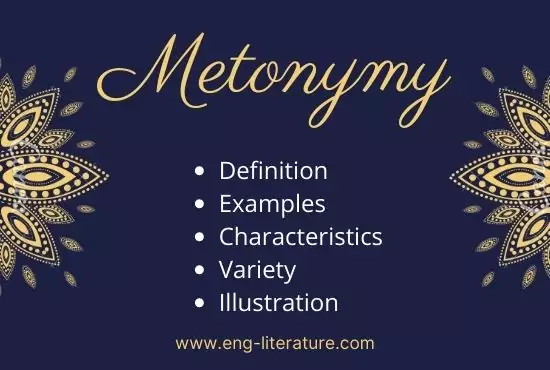Metonymy
Table of Contents
What is Metonymy?
The term metonymy comes from Gk. meta (change) and onama (name). As the very name signifies (a change of name), this figure consists in the substitution of the name of one thing for that of another.
Metonymy Definition
Metonymy is a figure in which the name of one thing is substituted for that of another with which it is loosely associated. In it the name of one thing is used for another. It is, according to Nesfield, ‘the substitution of the thing named for the thing meant’.
Interpretation of Metonymy
In this figure the name of an attribute of a thing is substituted for the thing itself. It is, thus, a figure in which one thing is signified by its accompaniment or attribute. An accompaniment or attribute is something that naturally or often goes with an object but not its organic, intrinsic or component part.
Metonymy Examples
The ‘crown’, for example, is an accompaniment of the king, yet by it we mean the ‘king’ himself. It should also be noted that in this figure the relation between the thing named (‘crown ) and the thing meant (‘king’) is only external (i.e., they can be physically separated without any harm to any one) and not of a component type.
In the sentence “He is ruined by the bottle” we get an example of metonymy, for hero the name of one thing ‘bottle’) is substituted for that of another (drink) associate with the former. The nature of their relation is only external, for both the bottle and the drink can be physically separated from each other,
Metonymy Characteristics
The chief characteristics of a metonymy are-
(i) One object is named but another object is meant,
(ii) There exists a certain relation between them.
(iii) This relation is not intimate but loose.
(iv) It is possible to separate both objects physically.
Varieties of Metonymy
The figure metonymy has several varieties, each of which is determined by the particular type of substitution ( of one thing for author ) used in this figure. These varieties are discorded below :
(A) The place for its production
In this variety the name of a place is used to designate a product originally made there or one made in imitation of it,
Examples of Metonymy
- All Arabia (i.e. the perfumes of Arabia) breathes from yonder box. (Pope)
- The book is bound in morocco (i.e. leather originally made in Morocco, a country in Africa).
- A bull is a China (i.e. porcelain articles originally made in China or china clay) shop.
- O for a beaker full of the warm South (i.e. wine made in the southern part of Europe).
Similarly Havana stands for cigar made in Havana, and Burgundy and Champagne stand for wine prepared in places.
(B) The passion for the object inspiring it
In this variety the name of a passion or act is mentioned to mean a person or object causing it,
Examples of Metonymy
1.He is the pride (i.e. object of pride) of his country.
- Shakespeare was England’s glory (i.e. object of glory)
- Lycidas, your sorrow (i.e. object of sorrow) is not dead. (Milton)
- The youth was the sigh (i.e. object of sigh) of her secret soul.
- He is a terror (i.e. object of terror) of our village.
- Our love, our hope, our sorrow, is not dead. (Shelley)
- That country was the hope of my youth and the joy of my old age.
- He gave the bridle-reins a shake
Said, ‘Adieu for evermore, my love !”
- “A thing of beauty is a joy (matter of joy) forever.”- Keats
(C) The author (or maker) for his work
In this variety the name of an author or a maker is mentioned to indicate his books, inventions or subjects of specialization.
Examples of Metonymy
- He was reading Browning (i.e., his works or his poetry).
- He is weak in Euclid (i.e., his geometry.)
- This type of character is quite common in Hardy (i.e., his novels).
- He went down the mine with a Davy (i.e., safety camp invented by him).
Similarly, Bradshaw stands for the railway time-table, Burtsen for the burner, Cardigan for the knitted woolen jacket, Derby for the race horse, Hansard for the parliamentary reports, Hartsom for the two-wheeled cab, Mackintosh for the waterproof overcoat and Morse for the signalling by code.
D) The act for the object inspiring it
In this variety an act is mentioned to mean a person or thing actuating it.
Examples of Metonymy
- The principles of liberty were the scoff (i.e., object of scoff) of every grinning courtier. (Macaulay)
- The people’s prayer, the glad diviner’s theme./The men’s vision, the old men’s dream. (Dryden)
- But half a plague and half a jest
Was still endured, beloved, caressed. (Scott)
- The applause, the delight, the wonder of our stage.
My Shakespeare arise.
(E) The container for the thing contained
In this variety we name the container but mean its content.
Examples of Metonymy
- All the world (i.e., its people) praises him.
- Forthwith he drank the fatal cup (i.e., its poisonous contents).
- The cup (i.e., its tea) that cheers but does not inebriate.
- The conquerors plundered the city (i.e., its inhabitants).
- Who steals my purse (i.e., its money) steals trash. (Shakespeare)
- The kettle (i.e., its water) boils.
- The entire auditorium (i.e., its listeners) welcomed her songs.
- The whole village (i.e. its people) came out to greet him.
- The pit (i.e., its occupants) cheered the heroine.
- He was playing to the gallery (i.e. its audience).
- She keeps a good table (i.e., its provisions).
- He keeps a good cellar (i.e. its wines).
- He has certainly the best stable (i.e., its horses) in the country.
- England (i.e., her people) hath need of thee. (Wordsworth)
- The heroic wealth of hall (1.c.. its lords) and bower (i.e., its ladies). (Wordsworth)
- All Persia (i.e., her people) hailed their favourite.
- And drowsy tinklings lull the distant folds (i.e., their sheep).
- She is proud of her wardrobe (i.e., its dresses).
(F) – The cause for the effect
In this variety our attention is drawn to an effect by means of its cause.
Examples of Metonymy
- They are basking in the sun (i.e., sun-shine, the effect is indicated by the sun, its cause).
- He writes a good hand (i.e., hand-writing).
- Yet oft a sigh prevails, and sorrows (i.e., tears, the effect of sorrow) fall. (Goldsmith)
- The day (i.e., day-light) through lofty gratings found way.
- Move him into the sun (i.e., sun-rays). (Owen)
- The bushes are gay with May (i.e., May blossom or ha thorn flowers, the effect of the month of May).
(G) The effect for the cause
In this variety the effect is named to indicate its cause.
Examples of Metonymy in Literature
- The bright death (i.e., sword, the cause of death) quivered at the victim’s throat. (Tennyson)
- Grey hairs (i.e., old age, their cause) should be respected.
- Swiftly flies the feathered death (i.e., arrow with feathers).
- Along the striped shades (i.e., trees, their cause) and bowers. (Milton)
- Their furrow (i.e., plough, its cause) oft the stubborn globe has broke. (Gray)
- May a favourable speed (i.e., wind, its cause) ruffle the mirrored mast of the ship. (Tennyson)
(H) The symbol for the thing symbolized
In this variety we use a symbol or sign to indicate a person or thing which commonly represents that symbol or sign.
Examples of Metonymy
- From the cradle (i.e., infancy) to the grave (i.e., death).
- Leather (i.e., shoe-making) pays better than learning.
- Grey hairs (i.e., old men) should be respected.
- War broke out between the Red Rose (i.e., House of York) and the White Rose (i.e., House of Lancaster).
- Doublet and hose (i.e., a man) ought to show itself courageous to petticoat (i. e., a woman).
- His cassock (i.e., clerical profession) stood in the way of his material advancement.
- Sceptre (i.e., governors) and crown (i.e., kings)
Must tumble down,
And in the dust be equal made
With the poor crooked scythe (i.e., cultivators) and spade (i.e., peasants). (Shirley)
- Altar (clergymen), sword (soldiers) and pen (writers),
Fireside (house-holders), the heroic wealth
(rich knights and heroes) of hall and bower
Have forfeited their ancient English dower
Of inward happiness. (Wordsworth)
Some other examples of this type are given below:
The laurel, for success
The bench. for judges
The House, for members of the House of Commons
The crown, the sceptre and the throne, for the king
Redcoat, for a British soldier
Blue-jacket, for a sailor
The cowl, for The altar monastic life
The helmet, for knighthood and the pulpit, for the church or the clergy
The mitre, for the bishop
The chair, for the president
The hearth, for domestic life
The red tape, for rigid official formalities
The stage, for the theatrical profession
Wealth, for rich people;
The bar, for barristers
The Cross, for Christianity,
The crescent (i.e., Islam).
(I) The instrument or organ for the agent
In this variety either an instrument or an organ is mentioned to indicate the person using it.
Examples of Metonymy
- The pen (i.e. writer) is mightier than the sword (i.e., soldier).
- The press (i.e., journalists) and the platform (i.e., orators) can greatly move the people.
- A thousand lances (i.e., soldiers) advanced to take possession of the fort.
- This is a nice production of the same chisel (i.e., sculptor).
- A smooth tongue (i.e., speaker) wins favour easily.
- A sweet throat (i.e., singer) is welcomed everywhere.
- The brand (i.e., infantry), the bridle (i.e., cavalry) and the oar (i.e., navy).
- The letter comes from a neat hand (i.e., one with good handwriting).
Illustrations
- I have read all of Milton.
This is a metonymy.
In this figure the name of one thing is substituted for another with which the former is loosely related.
Here the variety employed is: The author for his work. By Milton is meant the ‘works of Milton’. The relation between Milton and his works is an external one, for they can be easily separated from each other.
Also Read:
6) The village all declar’d how much he knew. (Goldsmith)
This is a metonymy.
In this figure the name of a thing is substituted for that of another with which the former is associated in some way.
The variety employed here is: The container for the thing contained. The word “village” in this case stands for the ‘villagers’. Their relation is somewhat loose, for both can be physically separated from each other.
Memory-aid
The easiest way to remember the different varieties of metonymy is to memorize the following sentence: PACk Egg, Sandwich and Ice-cream.
Of the above, take care of only the initial capitals and disregard the small letters. Now you get: PAC. ESI. Of these, each capital letter of the first part i.e., PAC) will have to be counted twice, while each letter of the second part (i.e., ESI) once only. If properly grasped, you will find the following:
P=(i) The place for its production : (ii) The passion for the object inspiring it.
A=(i) The author for his work; (II) The act for the object inspiring it.
C=(i) The container for the thing contained ; (ii) The cause for the effect.
E=(i) The effect for the cause.
S=(i) The symbol for the thing symbolized.
I=(i) The instrument or organ for the agent.

Hello, Viewers! Besides being the Founder and Owner of this website, I am a Government Officer. As a hardcore literary lover, I am pursuing my dream by writing notes and articles related to Literature. Drop me a line anytime, whether it’s about any queries or demands or just to share your well-being. I’d love to hear from you. Thanks for stopping by!
